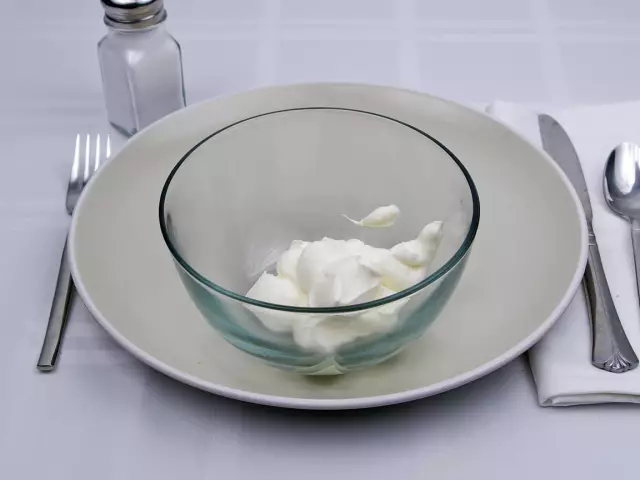- Author Rachel Wainwright [email protected].
- Public 2023-12-15 07:39.
- Last modified 2025-11-02 20:14.
Thermicon
Thermikon: instructions for use and reviews
- 1. Release form and composition
- 2. Pharmacological properties
- 3. Indications for use
- 4. Contraindications
- 5. Method of application and dosage
- 6. Side effects
- 7. Overdose
- 8. Special instructions
- 9. Drug interactions
- 10. Analogs
- 11. Terms and conditions of storage
- 12. Terms of dispensing from pharmacies
- 13. Reviews
- 14. Price in pharmacies
Latin name: Termicon
ATX code: D01AE15
Active ingredient: Terbinafine (Terbinafine)
Manufacturer: Pharmstandard OJSC, Russia
Description and photo update: 2019-12-08
Prices in pharmacies: from 219 rubles.
Buy

Thermikon is an antifungal agent of a wide spectrum of fungicidal and fungistatic action for systemic and local use.
Release form and composition
- tablets: flat-cylindrical, round, chamfered and scored, from white with a yellowish tinge to white (7 or 10 pcs. in blisters, 1, 2, 3 or 4 blisters in a cardboard box);
- spray for external use 1%: transparent colorless or light yellow liquid with a specific smell of ethyl alcohol (30 g each in polypropylene bottles, complete with a nozzle and a dosing pump, 1 set in a cardboard box);
- cream for external use 1%: a homogeneous mass of white color with a weak characteristic odor (15 g each in aluminum tubes, 1 tube in a cardboard box).
1 tablet contains:
- active substance: terbinafine hydrochloride - 281.25 mg (equivalent to 250 mg terbinafine);
- auxiliary components: microcrystalline cellulose, sodium starch glycolate, hydroxypropyl methylcellulose (hypromellose), magnesium stearate, lactose, aerosil (colloidal silicon dioxide).
1 ml of spray contains:
- active substance: terbinafine hydrochloride - 10 mg;
- auxiliary components: propylene glycol, rectified ethyl alcohol, poloxamer (proxanol 268), purified water.
1 g of cream contains:
- active substance: terbinafine hydrochloride - 10 mg;
- auxiliary components: benzyl alcohol, cetyl palmitate, sorbitan stearate, sodium hydroxide, stearyl alcohol, cetyl alcohol, isopropyl myristate, polysorbate 60, purified water.
Pharmacological properties
Pharmacodynamics
Terbinafine belongs to the group of allylamines, which causes a wide spectrum of its antifungal action. In low concentrations, it has a fungicidal effect on dermatophytes Epidermophyton floccosum, Microsporum canis, Trichophyton (T. violaceum, T. rubrum, T. verrucosum, T. tonsurans, T. mentagrophytes), yeast fungi (mainly Candida albicans), mold fungi (Scopulariopsis breasts, Cladosporium, Aspergillus and others) and some dimorphic fungi.
In relation to Candida fungi and its mycelial forms, Thermikon is characterized by fungicidal or fungistatic action, depending on the type of fungus.
Terbinafine inhibits the biosynthesis of the main component of the fungal cell membrane, ergosterol, at an early stage by inhibiting the enzyme squalene epoxidase.
When administered orally, the drug is ineffective in the treatment of varicoloured lichen provoked by Malassezia furfur. The substance does not affect the cytochrome P 450 system in humans and, accordingly, the metabolic processes of hormones or other drugs.
Pharmacokinetics
When taken orally, absorption of terbinafine is good. 50% of the dose taken is absorbed within 0.8 hours, and after 4.6 hours this amount of the drug is distributed in the body.
A single oral dose of 250 mg results in a maximum plasma concentration of terbinafine of 0.97 μg / ml, which is reached within 1-2 hours after administration. Bioavailability is 80%, and it is not affected by food intake.
The degree of binding of terbinafine to plasma proteins is 99%. The substance spreads at a high speed in the tissues of the body, penetrates the nail plates, the secretion of the sebaceous glands and the dermal layer of the skin, and also accumulates in significant concentrations in the subcutaneous tissue, skin, hair follicles and hair.
The half-life is 16-18 hours, and the terminal phase half-life reaches 200-400 hours. In the liver, terbinafine is biotransformed to inactive metabolites. 80% of the dose taken is excreted through the kidneys in the form of metabolites, the remainder (approximately 22%) - with feces.
The substance does not accumulate in the body. The pharmacokinetics of terbinafine does not depend on the age of the patient, however, its elimination may decrease with renal or liver dysfunction, which leads to a high level of concentration of the substance in the blood.
Terbinafine is excreted in breast milk. When applied topically, its absorption does not exceed 5%, and the systemic effect is insignificant.
Indications for use
Tablets (systemic therapy)
- mycoses of the scalp caused by Microsporum (microsporia) and Trichophyton (trichophytosis);
- onychomycosis caused by Microsporum canis, Trichophyton (rubrum, interdigitale, tonsurans, etc.), Epidermophyton floccosum;
- mycoses of the skin and nail plates caused by Epidermophyton floccosum, Microsporum (M. gypseum, M. canis) and Trichophyton (T. rubrum, verrucosum, mentagrophytes, violaceum);
- severe widespread infections of the smooth skin of the trunk and limbs caused by Dermatophyte fungi (dermatomycosis) and requiring systemic therapy;
- fungal infections caused by yeast-like Candida, primarily Candida albicans (candidiasis), localized on the skin and mucous membranes.
Spray and cream (contact therapy)
- fungal infections of the skin caused by dermatophytes, including mycoses of the feet, inguinal epidermophytosis, fungal lesions of the smooth skin of the body - therapy and prevention;
- pityriasis or pityriasis versicolor (fungal infection of the stratum corneum of the epidermis) - therapy.
The cream is also used for the treatment of fungal infections localized on the skin caused by the yeast-like Candida fungi, primarily Candida albicans (candidiasis, in particular, diaper rash).
Contraindications
According to the instructions, Thermikon in all dosage forms is contraindicated in case of increased individual sensitivity to the components of the drug.
Additional absolute contraindications for tablets (systemic use):
- the period of pregnancy and lactation (breastfeeding);
- children under 3 years old;
- child's body weight up to 20 kg.
Relative contraindications for all dosage forms (tablets, spray and cream are used with caution due to the increased likelihood of side effects):
- renal and / or hepatic impairment;
- oppression of bone marrow hematopoiesis;
- benign / malignant neoplasms (tumors);
- alcoholism;
- metabolic diseases;
- occlusion of the vessels of the extremities.
Also, the spray and cream are used with caution in children under the age of 12 years, since the safety profile of terbinafine in contact therapy for this age group is poorly understood.
During pregnancy, Termikon externally (spray and cream) is prescribed according to strict indications, when the intended benefit to the mother outweighs the potential risks to the fetus.
Since terbinafine is absorbed through the skin in clinically insignificant amounts, adverse effects on the infant through breast milk are unlikely.
Instructions for the use of Thermikon: method and dosage
The dosage regimen and the duration of the course of therapy with Thermicon, the doctor sets individually for each patient, depending on the localization of the infection and the severity of the course of the disease.
Elderly patients do not need a dose adjustment of terbinafine in any form of Thermicon.
Pills
The tablets are taken orally, once a day, after a meal.
The standard dose for adult patients, unless otherwise indicated, is 250 mg.
Duration of treatment:
- onychomycosis: average - 1.5-3 months; treatment of nails of hands and feet (except for the big toe) and treatment of younger patients - may take less than 3 months; treatment of the big toe - usually 3 months, but with a reduced rate of nail growth (rarely) - up to 6 months or more;
- dermatomycosis: trunk - 1 month; feet (plantar, interdigital, sock-like) - 0.5-1.5 months; shins - 0.5-1 month;
- candidiasis of the skin and mucous membranes: 0.5-1 month;
- mycosis of the scalp: the average duration of therapy is about 1 month, but for microsporia caused by Microsporum canis, longer treatment may be required.
The dose for children is determined depending on the body weight:
- 20-40 kg - 0.5 tablets (125 mg) 1 time / day;
- > 40 kg - 1 tablet (250 mg) once a day.
In severe renal failure, the dose of the drug for adult patients is reduced by 2 times, to 125 mg 1 time / day.
Spray
The spray is applied externally to cleaned and dried affected areas and adjacent areas of intact skin, spraying in an amount sufficient to moisturize them.
The standard frequency of use of the drug for adult patients, if there are no other prescriptions, with a weekly duration of the course of therapy:
- dermatomycosis of the trunk, legs, feet: 1 time / day;
- tinea versicolor: 2 times / day.
Cream
The cream is applied externally with a thin layer on the cleaned and dried affected areas and the adjacent areas of intact skin and rubbed lightly.
When treating infected surfaces with diaper rash (between the fingers, under the breast, between the buttocks and in the groin area), you can cover the places where the cream is applied with gauze, especially before bedtime.
Recommended dosage regimen:
- dermatomycosis of the trunk, legs, feet: 1 week course 1 time / day;
- candidiasis of the skin: a course of 1-2 weeks 1-2 times / day;
- versicolor versicolor: a course of 2 weeks 1-2 times / day.
Side effects
Tablets (systemic therapy)
- digestive system: nausea, decreased appetite, diarrhea, dyspepsia, abdominal pain, a feeling of fullness in the stomach, taste disturbances, including loss of taste (after stopping therapy, they take several weeks to recover); very rarely - disorders of the liver and bile ducts (cholestatic jaundice);
- musculoskeletal system: arthralgia, myalgia;
- hematopoietic system: thrombocytopenia, agranulocytosis, neutropenia;
- hypersensitivity reactions: rash, urticaria; very rarely - anaphylactoid reactions, Lyell's syndrome (toxic epidermal necrolysis), Stevens-Johnson syndrome (malignant exudative erythema).
Overdose symptoms are: pain in the lower abdomen and in the epigastric region, nausea, vomiting, dizziness.
For the treatment of the condition, gastric lavage should be performed, after which the patient should be given activated charcoal, if necessary, symptomatic treatment should be carried out.
Spray and cream (contact therapy)
The use of the cream and the Thermikon spray can cause local reactions: itching, burning, redness at the application sites and hypersensitivity reactions.
No cases of drug overdose in the form of a spray or cream for external use have been reported. But if the drug is accidentally ingested, adverse reactions may develop, comparable to the symptoms of an overdose of Thermicon in the form of tablets (pain in the lower abdomen and in the epigastric region, nausea, vomiting, dizziness).
Therapy: activated carbon, if necessary, symptomatic supportive treatment.
Overdose
When taking Thermikon tablets in high doses, overdose symptoms appear in the form of headache, pain in the epigastric region and lower abdomen, nausea, and vomiting.
As a treatment, you should immediately rinse the stomach and take activated charcoal. If necessary, symptomatic therapy is prescribed.
With local application of the drug, cases of overdose were not observed. If you accidentally take the Thermikon cream or spray inside, you can expect the same symptoms as with an overdose of tablets. In addition, it is necessary to take into account the presence of ethyl alcohol in the spray. Overdose treatment remains the same.
special instructions
With irregular treatment or premature termination, there is a risk of relapse.
The severity of clinical manifestations usually decreases in the first days of therapy. But if signs of improvement are not noted after 2 weeks from the start of treatment, it is necessary to verify the diagnosis.
The duration of the course of treatment is influenced by the presence of concomitant diseases and the condition of the nails at the beginning of therapy.
With onychomycosis, systemic use is justified only if most of the nail plates are totally affected, subungual hyperkeratosis is clearly expressed, and previous contact treatment was ineffective. In this case, the clinical response to the therapy of onychomycosis is usually noted several months later after mycological cure and discontinuation of the course of treatment. This is due to the rate of regrowth of a healthy nail plate. You should not remove the nail plates with onychomycosis of the hands - 3 weeks, with onychomycosis of the feet - 6 weeks.
During therapy with Thermikon, it is necessary to monitor the serum activity of hepatic transaminases, since in rare cases, after 3 months from the start of taking the drug, cholestasis and hepatitis may develop. The appearance of symptoms of liver dysfunction, such as lack of appetite, persistent nausea, weakness, abdominal pain, dark urine / colorless feces, jaundice, requires discontinuation of the drug.
With extreme caution, the drug is prescribed to patients with psoriasis, since occasionally terbinafine therapy can cause an exacerbation of psoriasis.
In order to prevent re-infection through shoes and underwear, general hygiene rules must be followed. In the course of therapy, after 2 weeks from the beginning, and at the end of the course, antifungal treatment of shoes, stockings and socks is performed.
If allergic reactions develop, the drug should be discontinued.
Thermicon cream and spray are intended exclusively for external use. It is important to avoid contact with the eyes as it may cause irritation. If a spray or cream accidentally gets into your eyes, they should be rinsed abundantly with running water, and if persistent irritation develops, consult a specialist.
In case of accidental ingestion of the spray into the respiratory tract, if any adverse reactions appear, especially if they persist, it is necessary to seek the advice of a specialist. The application of the Thermikon spray to damaged skin areas is done with extreme caution, since the alcohol contained in it can cause irritation.
Terbinafine has no effect on the ability to concentrate and the speed of psychomotor reactions.
Drug interactions
Terbinafine during systemic therapy may interact with the following drugs / substances:
- selective serotonin reuptake blockers (desipramine, fluvoxamine) and tricyclic antidepressants, β 1 -adrenergic blockers (propranolol, metoprolol), antiarrhythmics (propafenone, flecainide), MAO type B inhibitors (selegiline) and antipsychotic drugs) (haloperibazidol) (haloperibazidol) their metabolism by inhibiting the isoenzyme CYP2D6;
- inducers of isoenzymes of the cytochrome P 450 system (rifampicin): can accelerate the excretion of terbinafine from the body, which may require dose adjustment;
- inhibitors of isoenzymes of the cytochrome P 450 system (cimetidine): can slow down the elimination of terbinafine from the body, which may require dose adjustment;
- oral contraceptives: possible menstrual irregularities;
- caffeine: terbinafine reduces its clearance by 20% and increases the half-life by 31%;
- antipyrine, digoxin, warfarin: terbinafine does not affect their clearance;
- ethanol and other hepatotoxic substances / drugs: the risk of developing hepatotoxicity increases.
There are no data on the drug interaction between the spray and the Thermikon cream to date.
Analogs
Thermikon analogs are: Atifin, Binafin, Lamisil, Lamitel, Terbized-agio, Terbizil, Terbinafin, Terbinox, Terbifin, Tigal-Sanovel, Ungusan, Fungoterbin, Tsidokan, Exiter, Exifin.
Terms and conditions of storage
Store the drug out of the reach of children; tablets - without access to light, spray - do not freeze. Storage temperature: tablets - up to 25 ° C, spray and cream - up to 30 ° C.
Shelf life: tablets - 3 years, spray and cream - 2 years.
Terms of dispensing from pharmacies
The tablets are available with a prescription.
The cream and spray are available over the counter.
Reviews about Thermikon
Numerous reviews of Thermikon indicate that it is mainly used in the treatment of multi-colored lichen or mycoses of the skin of the feet. The drug in the form of tablets helps well in cases where external agents were useless.
Patients also report that the spray has worked well in the treatment of candidiasis. When used in combination with personal hygiene and taking additional medications, the disease quickly recedes.
Thermikon cream is actively used in the treatment of fungal diseases. According to experts, terbinafine is most active at the initial stage of the disease. However, since fungal lesions are quite diverse, only a doctor will be able to choose the correct therapy regimen, to whom most patients recommend contacting. Many of them also complain about the high cost of the drug in tablet form.
Price for Thermikon in pharmacies
On average, the price of Thermicon in tablets with a dosage of 250 mg is 504-670 rubles (for a pack of 14 pcs.) Or 877-1052 rubles (for a pack of 28 pcs.). You can buy 1% cream for about 223-270 rubles. Spray Thermikon will cost 325-439 rubles (for a bottle of 30 ml).
Thermikon: prices in online pharmacies
|
Drug name Price Pharmacy |
|
Thermicon 1% spray for external use 15 g 1 pc. 219 r Buy |
|
Thermicon 1% cream for external use 15 g 1 pc. 219 r Buy |
|
Thermikon 250 mg tablets 14 pcs. RUB 300 Buy |
|
Thermikon spray external 1% 15g n1 301 RUB Buy |
|
Thermicon cream 1% 15g 302 RUB Buy |
|
Thermicon 1% spray for external use 30 g 1 pc. 333 r Buy |
|
Thermicon tablets 250mg 14 pcs. 497 r Buy |
|
Thermikon spray for outside. approx. 1% 30g 498 r Buy |
|
Thermicon 250 mg tablets 28 pcs. RUB 619 Buy |
| See all offers from pharmacies |

Maria Kulkes Medical journalist About the author
Education: First Moscow State Medical University named after I. M. Sechenov, specialty "General Medicine".
Information about the drug is generalized, provided for informational purposes only and does not replace the official instructions. Self-medication is hazardous to health!






